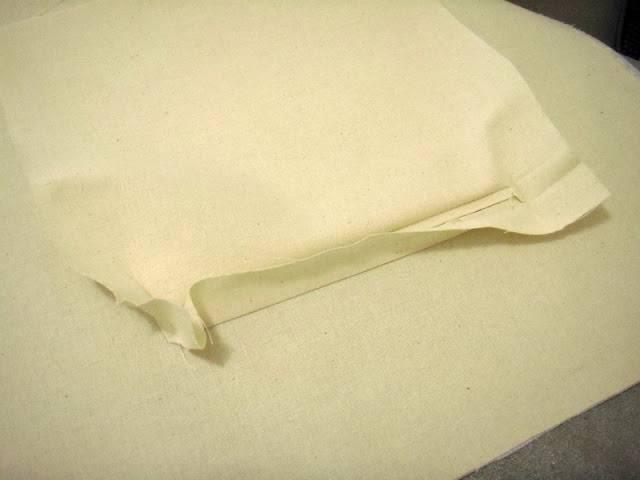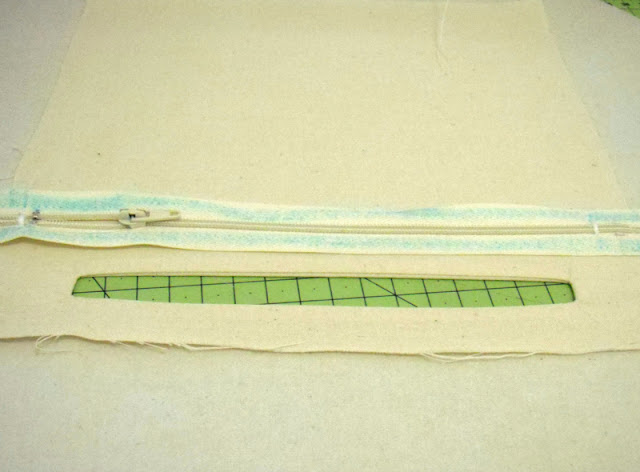You can use this tutorial for a pattern like The Saddlebag.
Take your outer flap piece and fuse the fleece to the wrong side of it. I used felt so serged the edges of mine. This helps if you have a very fray-able fabric. Is fray-able a real word?
Pin and baste your piping around the edge of your flap outer. I'm not going to cover piping here, I'm no expert but if you want to find out all about it, pop over to my lovely friend Christine's blog tutorial here.
The zipped pocket
Fuse one piece of your lightweight interfacing to your zipped pocket piece and one to the back of the lining where your pocket will be positioned.
To create the zipped pocket lay one interfaced piece right sides together in the centre of lining piece and pin at the edges.
Measure the teeth of your zipper and mark a box with fabric marker or pencil of that length with a height of 1/2” (1cm) in the centre of piece about 1” (2cm) from the top. I use a Frixion pen which disappears when heat is applied.
Draw a triangle at each end within the box and connect with a central line, this is where you will cut through both layers once sewn.
Sew around the outside of the box and then cut through the triangles and central line. Remove your pins.
To ensure your front piece lays flat, I like to do a bit of extra manipulating with my iron. Slide your iron up to the seam between the pieces and repeat for all 4 sides. You should end up with this.
Push the pocket piece through the lining piece to the back.
Press well and manipulate the fabric to lay flat. If you press from the front first, no matter how awkward then any puckers will be on the back.
 |
| Before pressing |
 |
| After pressing |
Next you need to pin or glue your zip to the back of your opening. Pinning will more likely shift it out of the way so I like to use a specific sewing glue such as the Hemline glue pen.
If you're in the UK you can get one here. This isn't the one I've got, it's about half the price!
I always go overboard on my glue but it dries clear and doesn't gunk up your needle so the more the better in my mind!
So now turn your fabric right side over and position your zip in the opening.
Change your presser foot for your zipper foot (or piping foot) to sew this and sew very slowly.
This is an adjustable piping foot. BUY ONE NOW, it will change your life.
These types of zips do take practise but if you're slow and steady you can achieve a professional finish easily.
Sew along the edge of your fabric opening trying to keep your zip straight. As you approach the zip pull leave the needle down and lift the presser foot.
See how close you can get with this foot?
Unzip the zip until the pull is out of your way, lower your presser foot and sew on until you need to re-zip.
Continue round all 4 sides of your opening.
Ignore the blue glue, it dries and disappears in a couple of hours. See how neat and close my stitching is the with piping foot? That's not from practice, it was like that the first time I tried using it as opposed to my zipper foot!
Pin the second pocket piece to the front pocket piece on the back of the lining without catching the lining piece and sew around all four sides.
Now to finish your flap lay your lining piece right sides together with your flap outer and stitch around the long curved edge leaving the top open.
Notch or pink the curves and turn right side out, pressing well.
Top stitch around the curve of the flap if you'd like.
Add one half of one of your magnetic clasps in the centre of the flap nearish the bottom. Keep the other half to one side for now. If you're not sure how to use magnetic clasps check out the tutorial here.
You won't use the other half of this snap til Saturday, so try not to lose it!
Tomorrow we'll go onto the lining and do the rest of the pockets.

















